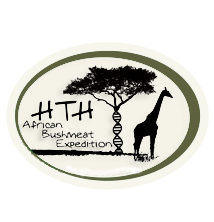


|
Conservation Science At High Tech High, students in Dr. Jay Vavra?s biotechnology class study genetics in the form of conservation forensics. Dr. Vavra?s quest to bring the science of DNA barcoding to his classroom began through collaboration with Dr. Oliver Ryder from the center for Conservation and Research for Endangered Species (CRES) of the San Diego Zoological Society to bring the field of genetics in the form of conservation forensics to a high school classroom. Much of the work in the conservation forensics class focused on combating the African Bushmeat Crisis, the illegal trade of meat from protected species, usually disguised as meat from a lawful origin. High Tech High students practiced and developed methods for extracting, isolating, amplifying, and sequencing DNA from dried jerky samples, which simulated the difficult-to-identify samples that might be found in an African market place or the cargo on an airplane traveling from Africa. The hope was to use the resulting DNA sequence to work in conjunction with partners such as CRES, Invitrogen, the Smithsonian Institute,and the Bushmeat Crisis Taskforce to develop a strategy for combating the bushmeat trade. In this first-ever High Tech High DNA project, students were able to effectively verify the origins of ostrich, turkey, and beef jerky. With the project?s successful methodology and collaboration, the students involved took the torch of DNA science and utilized this newly developed method of species identification to address conservation issues in San Diego Bay, ranging from plankton identification to studies on introduced species. (Vavra and Ryder, 2006)With regards to conservation biology, DNA barcoding is very amenable to the identification of species through trace samples. This method of non-invasive sampling contributes to conservation efforts on many levels. Trace samples allow scientists to identify species using feathers, feces, hair follicles, egg shells, ivory, and other matter. Because trace sampling can be obtained without harm to the specimen and does not require that a living organism is present, it can be used to help survey and control the transportation and trafficking of meats in the market. Method of DNA barcoding bushmeat
As previously mentioned, the bushmeat trade is a key concern for the conservation of endangered species throughout Africa. Illegally hunted animals often end up in markets or are mislabeled as legal meats and sold. Unfortunately, processed meat from illegally-hunted animals becomes visibly indistinguishable from the meat of legal game. Similar problems exist in other parts of the world as well. In Japan, the trade of whale meat known as kujira faces similar difficulties with regulation of poaching and trafficking. The International Whaling Commission (IWC) places strict quotas which restrict the number, species, and location of the whales acceptable for trade. Biologists Stephen Palumbi and Scott Baker decided to investigate the whale meat to determine how much actually came from legal minke whales. ?If you can?t tell the difference between a minke whale and, say, a fin whale when it?s wrapped in cellophane, how can you police that? That?s where the genetic technique is really powerful,? says Palumbi. Indeed, the DNA barcode of fourteen labeled ?minke? samples proved to be meat not just from minke, but also four restricted species. The applications of DNA barcoding remain highly valuable in an array of situations. (Palumbi and Baker, 1994; Edgar, 1995). The science proved to be so strongly applicable to conservation in so many ways that we decided to develop our own in-house method of DNA extraction. One of the strongest arguments against DNA barcoding as a solution for trafficking illegal meats or a primary means of identifying species is the amount of equipment, technology, knowledge, and funding required to process the delicate material. At High Tech High, we strove to establish a simplified approach that could be performed in our high school?s biotechnology laboratory. Since the project began, the High Tech High DNA barcoding process has optimized and refined its approaches involved in the isolation, extraction, and identification of species through a specific DNA sequence. ?I regard it as not just an appropriate activity, given the conservation education goals of CRES, but also a privilege to interact with inquisitive students who are intent on applying scientific methods in support of endangered species conservation efforts. These people are the future of the field in which I have had the opportunity to spend my career. It is encouraging to see caring, curious, and capable young people coming forward to help address the enormous tasks that face society in preserving earth's legacy of biodiversity. Hats off to you all!? ?High Tech High's innovative approach is serving as a model for educational programs in ecological assessment and environmental awareness in the U.S. and abroad. We congratulate them on their achievements and look forward to their continued success in advancing marine conservation and science literacy.?
|

